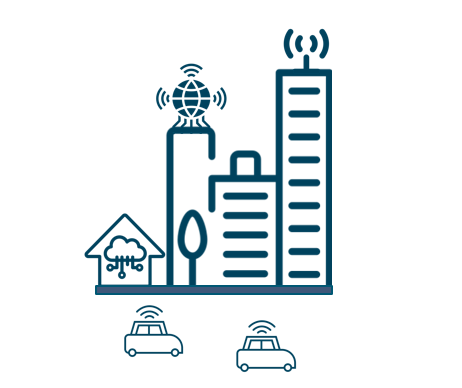Enhanced / Interoperable Internet of Things (IoT)
The Internet of Things (IoT) is a continuously and rapidly growing technological innovation, aimed at making our daily activities more digitally connected. Through greater interconnected and better data analysis, IoT allows for more efficient, as well as more well-informed, decision-making capacity. This is done by making everyday physical objects internet-enabled, through their combination with sensors, processing capabilities and other software which allows for the sharing and interexchange of data. This process promises ‘to transform the way we work, live and play’ (Singhania, 2015). This merging of the physical and the virtual allows for the delivery of more innovative smart city solutions to real-world urban problems. At the forefront of the digital transformation, IoT can help in all sorts of scenarios, from traffic congestion to smart home monitoring, energy efficiency, and a wide range of security matters. Currently, however, although there are a whole variety of IoT-enabled devices on the market, many of which have been implemented to help improve municipal infrastructure, the potential of the technology is often not reached. This results from there being various network and device standards, which limit the capacity of devices not sharing these standards to interconnect, speak to each other, and thus share data for optimal network capacity. The answer to this is Enhanced or Interoperable IoT, allowing for seamless integration and interconnectivity of IoT-enabled devices, vastly expanding the potential for this technology usage in smart city problem-solving. Many urban technology solutions can work better and more effectively when they are working together within a connected system. For instance, commuters would benefit from knowing the best route to take with up-to-date traffic information, whilst also knowing the current parking spaces status. Without data feedback from all the involved devices, such information cannot be provided reliably. However, there is no universal standard for IoT-enabled devices due to the relative newness of the technology. This reduces the ability of devices to connect together and share data, essentially limiting the capacity of IoT solutions. This problem must be resolved to harness the true potential of internet-enabled technologies. One of the benefits of IoT is to track the use of devices through data analysis. This can help to limit the energy inefficiency of devices used across a wide variety of activities. IoT also allows for devices to be controlled, or limited in their usage, remotely. Without internet-connected devices, or without those which can communicate with each other, the sharing of important data for the analysis of city infrastructure is severely limited. Without such analysis, it will remain unclear how well urban infrastructure and smart city solutions are operating. Source: Vasilov, L. (2021) Knowledge byte: Building blocks of IOT architecture , Cloud Credential Council . Available at: www.cloudcredential.org/blog/knowledge-byte-building-blocks-of-iot-architecture/ (Accessed: November 1, 2022).
